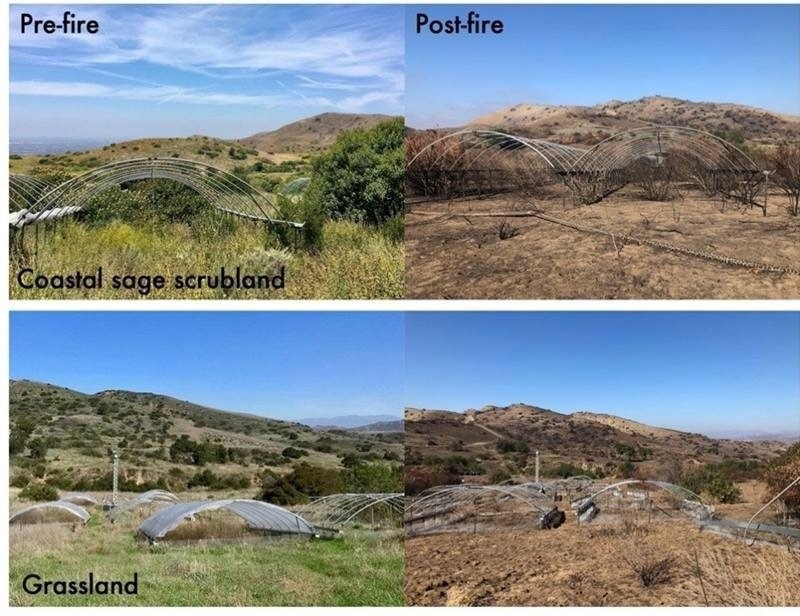Reviewed by Mila PereraSep 21 2022
The bacteria in the surface-level soil affect the global carbon cycle. These microorganisms generally break down dead stems and leaves, pumping carbon into the soil and the atmosphere. These microbes are also sensitive to the environmental changes that occur.
 Loma Ridge Global Change Experiment treatment plots in the California coastal sage scrubland and grassland before and after the Silverado fire in October 2020. Image Credit: Nick Scales and Claudia Weihe, University of California, Irvine
Loma Ridge Global Change Experiment treatment plots in the California coastal sage scrubland and grassland before and after the Silverado fire in October 2020. Image Credit: Nick Scales and Claudia Weihe, University of California, Irvine
Forecasting the carbon cycle shift due to climate change requires researchers to comprehend how the microorganisms in the soil respond to environmental shocks like wildfire and drought. Researchers are unaware of how deep these disruptions penetrate the soil's surface to impact the microbes.
Recent research discovered that bacterial communities closer to the soil surface are much more sensitive to fire and drought. The findings indicate that deeper soils might be a refuge for bacterial communities exposed to environmental disturbances such as wildfires.
Microbiologists frequently treat the top 10 cm of soil as a homogeneous layer. This research, however, demonstrates that bacterial populations adapt to environmental changes in a depth-dependent manner.
Microbial populations just 1 cm below the soil surface are remarkably resistant to grassland and shrubland fires. This could help to maintain soil nutrient cycling, perhaps boosting ecosystem health and recovery over time.
Summary
The current research evaluated the reaction of bacterial communities close to the soil surface to wildfire and drought - two disturbances that are anticipated to become increasingly intense and frequent in many parts of the globe.
The scientists gathered samples from three depths: the top 2 cm of soil, the top 10 cm of soil, and the leaf litter layer on the soil surface.
They took samples before and up to a year after a fire burned through the Loma Ridge Global Change Experiment, a California field study simulating drought in a semi-arid grassland and adjacent coastal sage scrubland for over ten years.
The researchers used 16S amplicon sequencing to track bacterial community composition and how it altered with drought, fire, and soil depth over time.
The scientists discovered that the environmental factors significantly impacted the bacterial communities in leaf litter and surface soil layers, decreasing with depth. The sensitivity of the bacterial community to drought, for example, was three times higher in the leaf litter layer compared to that of the top 10 cm of soil.
Wildfire also changed the composition of the bacterial community in the leaf litter layer but did not alter the communities in the soil.
Notably, soil bacterial communities tolerated fire regardless of them being exposed to drought earlier. These observations are vital as bacteria in surface soil and litter process, store, and respire carbon.
Nutrients can also flow across the soil when it rains, so shocks to microorganisms in one area of the soil can have a cascading impact on the organisms in other areas.
Knowing that microorganisms just below the soil surface may be protected from drought and fire provides a glimmer of hope that critical microbiome advantages such as carbon cycling may be resilient to climate change.
This study was supported by the Department of Energy Office of Science, the Office of Biological and Environmental Research.
Journal Reference
Barbour, K.M., et al. (2022) Bacterial community response to environmental change varies with depth in the surface soil. Soil Biology and Biochemistry. doi.org/10.1016/j.soilbio.2022.108761.